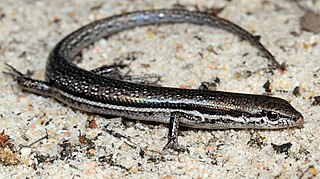
Skinks are lizards belonging to the family Scincidae, a family in the infraorder Scincomorpha. With more than 1,500 described species across 100 different taxonomic genera, the family Scincidae is one of the most diverse families of lizards. Skinks are characterized by their smaller legs in comparison to typical lizards and are found in different habitats except arctic and subarctic regions.

Morethia, commonly called Morethia skinks or firetail skinks, is a genus of skinks in the order Squamata that are found in Australia.

The western blue-tongued lizard, also known as the western blue-tongued skink, is a large skink native to Australia. It is one of six species of blue-tongued skinks found in Australia, though further species are found in New Guinea and Indonesia.
The Hamelin ctenotus or Hamelin Pool ctenotus is a species of skink in the family Scincidae. It is found only in Western Australia.

Menetia greyii, commonly known as the common dwarf skink or Grey's skink, is a species of lizard in the family Scincidae. The species is native to mainland Australia and Indonesia.

Morethia boulengeri is a species of lizard in the family Scincidae. The species is endemic to Australia.
The coastal plains skink is a species of skinks, found on the Swan Coastal Plain south of Perth, Western Australia.
Rhinoplocephalus is a genus of snake in the family Elapidae. The genus is monotypic, containing the sole species Rhinoplocephalus bicolor, known commonly as the square-nosed snake, Müller's snake, or Muller's [sic] snake. The species is endemic to south-western Australia.
The southwestern cool-skink is a species of skink.

Eugongylinae is a subfamily of skinks within the family Scincidae. The genera in this subfamily were previously found to belong the Eugongylus group in the large subfamily Lygosominae.

The southwestern crevice-skink is a species of large skink, a lizard in the family Scincidae. The species is native to western Australia.

The Pilbara crevice-skink is a species of large skink, a lizard in the family Scincidae. The species is native to western Australia.

The night skink, nocturnal desert-skink or striated egernia is a species of skink, a lizard in the family Scincidae. The species is endemic to western Australia.

The shrubland Morethia skink is a species of skink endemic to Australia, of the family Scincidae, found in New South Wales, South Australia, Victoria (Australia), Western Australia in Australia.
Morethia ruficauda, the lined firetail skink, is a species of skink found in Northern Territory, Western Australia and South Australia in Australia.
Morethia storri, also known commonly as the top end firetail skink or Storr's morethia, is a species of lizard in the family Scincidae. The species is endemic to Australia.
Morethia taeniopleura, the northeastern firetail skink, is a species of skink found in Queensland in Australia.
The mosaic desert skink is a species of skink found in Western Australia.
The ghost skink is a species of skink endemic to Australia.










